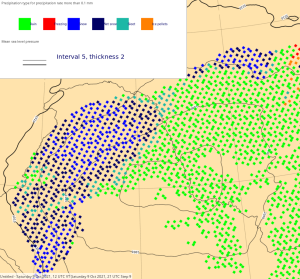| Table of Contents |
|---|
IFS cycle 47r3 is delivering noteworthy changes in the characteristics of many of the forecast fields (such as precipitation) and forecast products regularly used by forecasters and others. These changes are probably more substantial, as a whole, than anything we have seen with any ECMWF cycle in the last 10 years. This page aims to highlight the key differences.
...
Although ECMWF has used both systematic and case study analyses to document the most significant and substantial changes for users, the list below can not be considered exhaustive - other features may well come to light in the coming months.
...
Precipitation
A large set of cases in different "synoptic type" categories where precipitation tends to occur were examined; these included orographic rainfall (convective, large-scale, mix), cold fronts, warm fronts, diurnal convection over land, SST-triggered convection, tropical convection, MCSs (mesoscale convective systems). In almost all of these classes the precipitation rate patterns look to be systematically different in 47r3.
...
"Mixed picture" means marked regional variations. The maximum change at any location in any of these classes is about 15%.
Regional average changes, over summer and winter seasons, at a 48-hour lead time, are illustrated on the following plot (Warm warm colours mean more cloud in 47r3).
High cloud in particular tends to show more sharply defined edges in 47r3. The example below highlights far more areas of cloud cover >99% (i.e. >0.99), and similarly a much reduced spatial coverage of areas with 50-99% cover. It should be added that the non-opaque nature of high cloud makes defining full cover in a meaningful way rather difficult.
...
The plots below, from a day with heavy rain in NW Europe, nicely illustrate point 2 above (plots of rainfall rate with mslp are added in each case as a reference point). One can also see that any counteracting effect of the highest rainfall rates tending to be even higher in 47r3 is negligible by comparison.
The following panels compare visibility in an October case over with snow and rain centred on northernmost China. Cycle 47r3 looks much more realistic with shows lower values overall in the snow than in the rain; this looks more realistic than 47r2 which has the opposite was seen in 47r2.
| Diagnosed Ppn type | Total Precipitation Rate | Total Snowfall Rate | Visibility | |
47r2 (old cycle) | ||||
47r3 (new cycle) |
...
Wind gusts
The 10m wind gust parametrisation has been changed in two ways in cycle 47r3; the first change reduces the standard 'turbulent gusts' by 7%, the second change reduces the convective gust addition by 50% (whenever it is applied). The net result is slightly lower gusts overall, albeit with the size of the impact depending on the situation.
...
Sometimes, for other reasons, gusts (and mean winds) can be higher in 47r3 than in 47r2, even when pressure gradients are almost identical. Such cases are in the minority however, as illustrated in the single-time comparison below.
...
Miscellaneous
Precipitation type products
Precipitation type products (in map and site-specific bar chart formats) are expected to show a reduced probability of precipitation falling at any given time, due to the change in spatial coverage of precipitation in cycle 47r3 noted above. The differences will be most apparent in summer, when convective rain, which exhibits the largest reduction in areal coverage, is more prevalent. Products in this class will thus have a "drier" look to them (although on bar charts a slight increase in higher rate probabilities is also expected). We may adjust the minimum rate thresholds used for these products at some future point, following more verification work; for the time being these thresholds remain the same.
Soil Moisture
One knock-on effect of the structural changes to precipitation fields described in the section above is that soil moisture now exhibits more spatial variability, particularly for soil level 1 (corresponding to the top 7cm of soil). Note the increased 'noise' on the new cycle plot below. There may be some direct impact on surface weather parameters although this has not been studied directly.
...













